Travel
Traveling on a Budget? These 10 National Parks Are the Most Affordable to Visit.

Our national parks are awe-inspiring and family-friendly destinations. That said, some are cheaper to get to and stay in or near than others. I know: from 2020 to 2023, I visited all 63 U.S. national parks as a columnist for Outside, in a van and on a shoestring budget. Then I wrote a book about it, called Feral.
To come up with a list of the most affordable parks, I looked at the primary costs that go into a national park trip—namely proximity to a major airport, transportation and accommodation, and the top activities there. The results reflect the cost of lodging for three nights for an average-priced hotel room or Airbnb in May; park entrance fees and other ancillary fees included in my suggested itinerary; and a rental car for four days. I have not factored in airfare, food, and gas, which will vary pending where you’re based and h how much you dine out and drive.
These are the 10 most affordable parks to visit based on my research.
1. Great Basin National Park, Nevada
Approximate total cost: From $204
- Average car rental for four days: $166
- Average campground site / hotel for three nights: $30 / $363
- Park entrance fee: Free
- Lehman Caves tour: $8
How I’d do it: The nearest airport—Cedar City, Utah—is 142 miles away, so gas will likely be your main expense when visiting Great Basin. If you’re camping, try to snag a coveted free site at Sacramento Pass Campground; otherwise, post up in Ely, 55 miles west, which has more hotel and food options than tiny Baker, just outside the park gates.
Spend your first day admiring the 3,000-year-old trees on the Bristlecone Trail and picnicking near the Wheeler Peak Campground, which is offering first-come, first-served sites for the rest of 2024 ($20).
On day two, reserve tickets for a tour of the Lehman Caves (from $8 per adult and $4 per child) and learn about the region’s rich Native history at the Baker Archaeological Site (free).
Make day three all about big-mile hikes, either summiting 13,063-foot Wheeler Peak (the second-highest in Nevada) or traversing fragrant sagebrush slopes on a ten-mile round-trip up to shimmering Baker Lake. Fuel your post-hike hunger at Sugar, Salt and Malt in Baker.
Best Time to Visit: June through September
2. Death Valley National Park, California and Nevada
Approximate total cost: From $235
- Average car rental for four days: $157
- Average campground site / hotel for three nights: $48 / $297
- Park entrance fee: $30
How I’d do it: Most commercial flights in this region go to Las Vegas. From there it’s a 125-mile drive north to the Wild West town of Beatty, which is funky and close to noteworthy ghost towns, like Rhyolite. Camping is available inside the park and options range from free primitive sites to the full-service Furnace Creek (from $30).
Your first day in the park, check out the narrow, multicolored Mosaic Canyon on foot. During the cooler early-evening hours, take in the sunset hues while hiking or boogie-boarding at Mesquite Flat Sand Dunes (don’t forget your snowboard or boogie board, which Reddit readers have reported using on these slopes).
The next day, wake while it’s still dark so you can snap some sunrise pics at Zabriskie Point, then move on to marvel at the bizarre geological formations along Badwater Road, stopping at Devil’s Golf Course, Artists Palette, Golden Canyon, and Badwater Basin (the lowest point in North America) along the way.
If you’re a peak bagger, you could spend your third day summiting 11,049-foot Telescope Peak, but for anyone less ambitious, I’d recommend a stroll around both Rhyolite Ghost Town and the free Goldwell Open Air Museum next door. Reminisce that night over a pint and a pizza at Beatty’s Sourdough Saloon.
Best Time to Visit: November through April
3. Great Sand Dunes National Park and Preserve, Colorado

Approximate total cost: From $244
- Average car rental for four days: $139
- Average campground site / hotel for three nights: $60 / $492
- Park entrance fee: $25
- Board rental: $20 per day
How I’d do it: A visit to Great Sand Dunes is really a visit to the Sangre de Cristo Mountains, the southernmost Rockies. You could fly into Denver and drive the 250 miles south, but flights into Alamosa, just 30 miles from the park, are relatively affordable.
Book a hotel or an Airbnb in quaint Crestone (or book a campsite inside the park), rent a sand board at Oasis Store (four miles from the park entrance), then drive into the park and spend your first day amid the massive dune field—the tallest in North America—making a point to top out on the High Dune on First Ridge and surf down the steep slopes. Afterwards, cool off in Medano Creek if the water is flowing steadily.
Day two, explore the woodlands and admire the incredible views of the imposing peaks along the 7.5-mile Mosca Pass Trail.
For your final full day, I’d opt for a visit to Valley View Hot Springs or a challenging hike to Willow Lake.
Best Time to Visit: May through October
4. Cuyahoga Valley National Park, Ohio

Approximate total cost: From $246
- Average car rental for four days: $147
- Average campground site / hotel for three nights: $66 / $360
- Park entrance fee: Free
- Bike rental: From $15
- Railroad tour: From $18
How I’d do it: Look for an affordable vacation rental in Akron, which is 38 miles south of Cleveland and slightly closer to this 33,000-acre park’s top sites. Or check out Stow Silver Springs Campground ($22 for anyone not from the town of Stow), 15 minutes from the park.
Spend your first day trekking from the 19th-century Stanford House to the roaring Brandywine Falls, a 4.8-mile meander (see the Gaia GPS map of this route below). Before the sun sets, make your way to viewpoints along the Ledges Trail.
Learn more about the Cuyahoga’s history of locks and canals on day two by renting a bicycle from Eddy’s Bike Shop and spinning your wheels along a stretch of the riverside Towpath Trail.
Take a chill pill on your last day and ride the Cuyahoga Valley Scenic Railroad from Akron to Peninsula, with the option of an elegant multi-course meal aboard a vintage car. Visiting in October? Good choice; that’s when a Technicolor display of epic fall foliage is everywhere you look.
Best Time to Visit: April through June and September through October
5. Carlsbad Caverns + Guadalupe Mountains National Parks, New Mexico and Texas
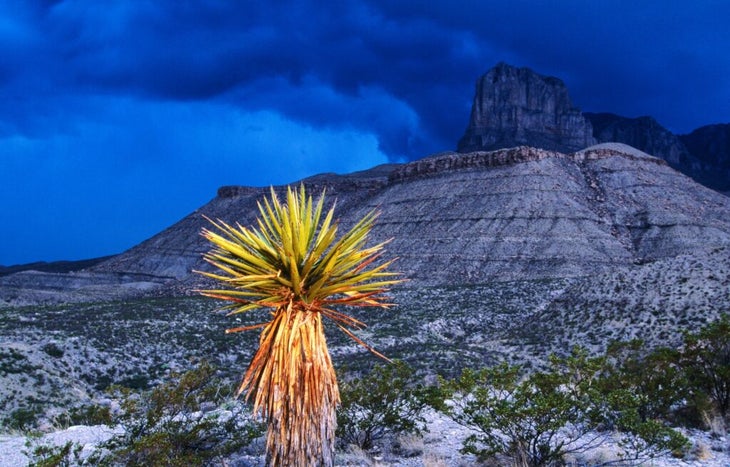
Approximate total cost: From $255
- Average car rental for four days: $150
- Average campground site / hotel for three nights: $60 / $441
- Park entrance fees: $15 and $10, respectively
- Lower Cave tour: $20
How I’d do it: Hit two national parks in one trip, flying into El Paso, Texas, and then basing yourself in the affordable hamlet of Carlsbad, New Mexico. Both Carlsbad Caverns and Guadalupe Mountains are economical parks and amazing in their own way, and the latter is home to an excellent developed campground.
Book a timed-entry reservation and spend your first day strolling Carlsbad, heading into its depths via its natural entrance (as opposed to an elevator down from the visitor center). If you’re visiting late May through October, stay after hours and take advantage of the free Bat Flight Program, led by a park ranger; this blew my mind as a nine-year-old.
Wake up early the next day, drive to Guadalupe Mountains National Park, and summit the “Top of Texas” on an 4.1-mile ascent of Guadalupe Peak for jaw-dropping views of the vast Chihuahuan Desert.
Take it easy on day three and return to Carlsbad Caverns for the three-hour, ranger-guided Lower Cave tour ($20 per adult and $10 per child).
Best Time to Visit: March to June, September to November
6. Mount Rainier National Park, Washington
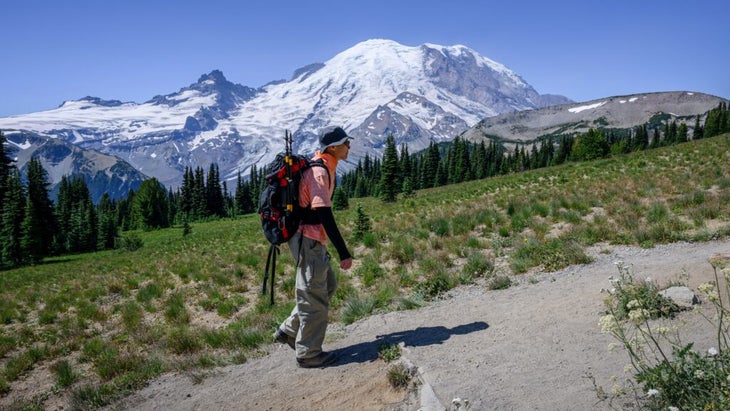
Approximate total cost: From $262
- Average car rental for four days: $172
- Average campground site / hotel for three nights: $60 / $465
- Park entrance fee: $30
How I’d do it: Fly into Seattle-Tacoma International Airport and then plan to stay in Tacoma, an hour north of the park. Though it’s not as woodsy as Rainier’s gateway town of Ashford, Tacoma has loads of affordable motels and vacation rentals for park-goers who’d rather not pitch a tent in the wet Washington weather.
If you’ve secured a timed-entry permit, spend your first day exploring the iconic Paradise area of the park, hiking to the perfect photo op at Myrtle Falls or breaking a sweat on the 5.5-mile Skyline Trail Loop. Pop in and marvel at the fabulous architecture of the historic Paradise Inn, while you’re at it.
On day two, circumnavigate the glacier-capped peak by car, stopping at Martha Falls, Reflection Lake, and the adorable town of Enumclaw, making a pit stop at Pie Goddess along the way.
On your last full day, get off the beaten path and brave the bumpy road up to sapphire Mowich Lake. Picnic in a designated area near the lake, take a dip in the alpine tarn, or challenge yourself on the 7.5-mile hike (one-way) to the Tolmie Peak Lookout.
Best Time to Visit: June through September
7. Theodore Roosevelt National Park, North Dakota

Approximate total cost: From $276
- Average car rental for four days: $151
- Average campground site / hotel for three nights: $42 / $282
- Park entrance fee: $30
- Trail ride: From $53
How I’d do it: Though it’s out of the way from a major airport—the nearest is in Bismarck, 135 miles east—Theodore Roosevelt is fantastic for hiking and wildlife viewing. Plus, it boasts an uber-affordable in-park campground ($14).
Savor the prairie- and badlands-filled drive to the park’s South Unit on your first day, then spend the remaining hours scouting for wild horses, herds of bison, and playful prairie dogs on the area’s 48-mile scenic drive. Stop at the Maltese Cross Cabin, a former home of Theodore Roosevelt himself, before taking in the sunset from the one-mile Painted Canyon Nature Trail.
If you’re not camping at the park, spend the night in Watford City, which is cheaper and only slightly farther away than the gateway town of Medora.
On day two, splurge on a morning trail ride through the colorful badlands, and check out the longer Painted Canyon Trail in the afternoon.
Reserve day three for the park’s North Unit, home to a 14-mile scenic drive where you might spy bison, coyotes, and longhorn cattle. But you don’t want to be driving around all day. I suggest a trail run along the easy, four-mile Caprock Coulee Loop, which overlooks the Little Missouri River.
Best Time to Visit: May through September
8. Black Canyon of the Gunnison National Park, Colorado
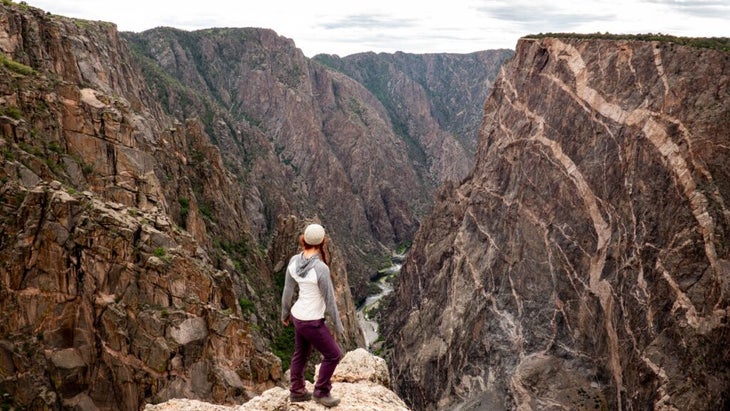
Approximate total cost: From $279
- Average car rental for four days: $189
- Average campground site / hotel for three nights: $60 / $396
- Park entrance fee: $30
How I’d do it: Fly into Montrose Airport (with daily service from four major U.S. airports) and pick up your rental car; from there it’s a mere 15 miles to the park’s south entrance. You’ll be basing out of Montrose, which has affordable hotels and Airbnbs, but for even more of a savings, nab a site at the park’s South Rim Campground ($20 per night).
On your first day in the park, stop at Tomichi Point for jaw-dropping views of the canyon’s dark gneiss before hitting up the South Rim Visitor Center, which has plenty of parking and is the starting point for the Oak Flat Trail and the connecting Gunnison Route, together offering an easy few miles of wandering below the canyon’s steep rim. Motor along exploring the south rim’s seven-mile scenic drive, pausing at the Painted Wall Overlook and, if you’re up for it, another hike, this time out to Warner Point.
On your second day, head to the less touristed north rim and enjoy equally less crowded viewpoints (the aptly named Exclamation Point is a must). Stretch your legs on a 7.2-mile trek up Green Mountain before exiting the park, making a beeline for Colorado Boy Pizzeria in Montrose and rewarding yourself with a slice and a cold one.
Maximize your trip by tacking on a detour to Mesa Verde National Park (142 miles from Montrose) on your final day, or go fishing for trout in the Gunnison River.
Best Time to Visit: May through October
9. Crater Lake National Park, Oregon
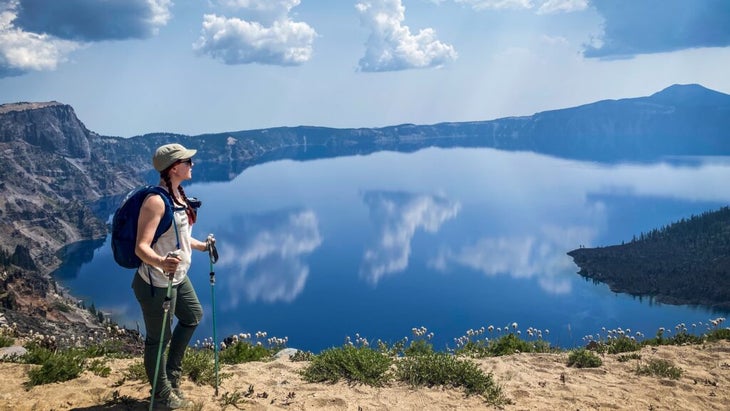
Approximate total cost: From $290
- Average car rental for four days: $169
- Average campground site / hotel for three nights: $63 / $435
- Park entrance fee in summer: $30
- Boat ride: $28
How I’d do it: Major airlines service Medford, 63 miles southwest of the national park, and accommodations in southern Oregon are relatively cheap, so I suggest basing yourself in Medford itself or in Klamath Falls, 45 miles southeast of the park. Itching to camp? Book early and grab a site in the park at Mazama Campground ($21).
Go big on your first day and hike to the Watchman Peak fire lookout (see Gaia GPS map below) for second-to-none views of Crater Lake’s otherworldly deep blue. I also like the hike down to the lake’s chilly fresh water via the steep Cleetwood Cove Trail.
If you’re not interested in backpacking a segment of the Pacific Crest Trail—33 miles of it run through the park—utilize day two to explore Wizard Island, near the lake’s western edge (boat shuttles cost $28 per adult and $18 per child). The thrill of standing atop the lake’s only major island will wow you.
On day three, soak it all in on a scenic drive around the entirety of Crater Lake—a 33-mile route—stopping for snapshots at the park’s 30 scenic overlooks.
Best Time to Visit: July through September
10. Saguaro National Park, Arizona
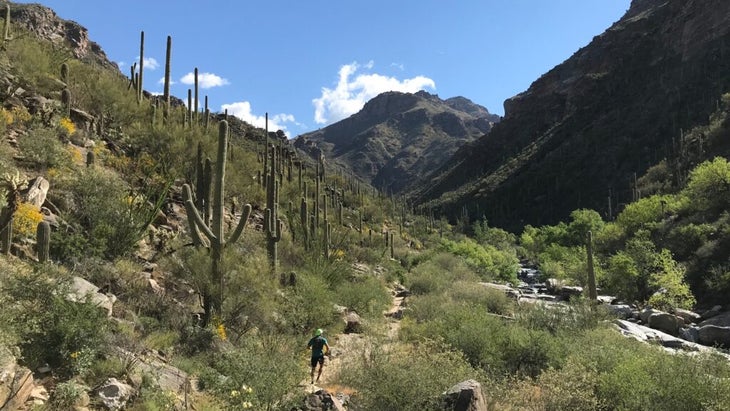
Approximate total cost: From $338
- Average car rental for four days: $184
- Average campground site / hotel for three nights: $75 / $339
- Park entrance fee: $25
- Museum fee: $30
- Colossal Cave tour: $24
How I’d do it: Saguaro straddles Tucson, an affordable and road-trip-friendly destination for desert lovers. Its eastern Rincon Mountain District is a mere 25-minute drive from the local airport, so drop your bags at your Tucson motel or a campsite in nearby Catalina State Park (from $25), and then spend your first few hours craning your neck up at century-old cacti along Cactus Forest Drive. Next, get your heart rate going on the Tanque Verde Ridge Trail, either just a portion of it or the full eight miles one-way.
On day two, learn about the area’s flora and fauna at the Arizona-Sonora Desert Museum before setting out for the Scenic Bajada Loop Drive in the park’s western Tucson Mountain District.
On day three, summit 4,688-foot Wasson Peak, and picnic at Mam-A-Gah, or branch out for a little something different: a tour of the nearby Colossal Cave Mountain Park.
Best Time to Visit: October through April
Honorable Mentions
There were a handful of affordable national parks that scored just shy of making my list. But if you’re hungry for more budget-friendly park ideas, I recommend checking out Redwood National Park, in California; Congaree, in South Carolina; White Sands, in New Mexico; North Cascades, in Washington; and Gateway Arch, in Missouri.
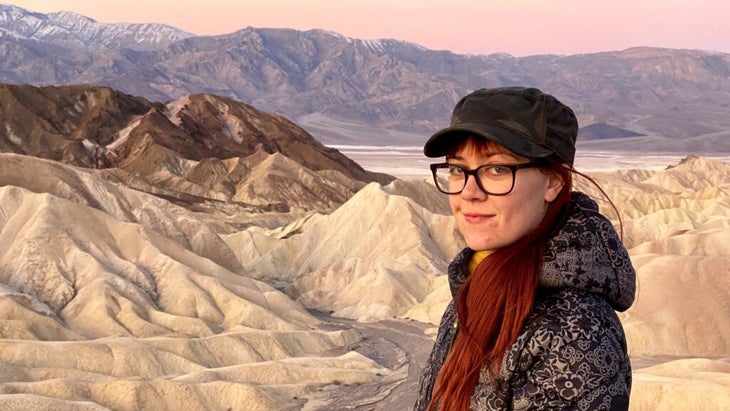
Emily Pennington is a regular contributor to Outside and continues to travel far and wide. This year she’s returning to Great Sand Dunes and looks forward to exploring every corner of her new home state, Colorado.







:max_bytes(150000):strip_icc()/roundup-writereditor-loved-deals-tout-f5de51f85de145b2b1eb99cdb7b6cb84.jpg)


